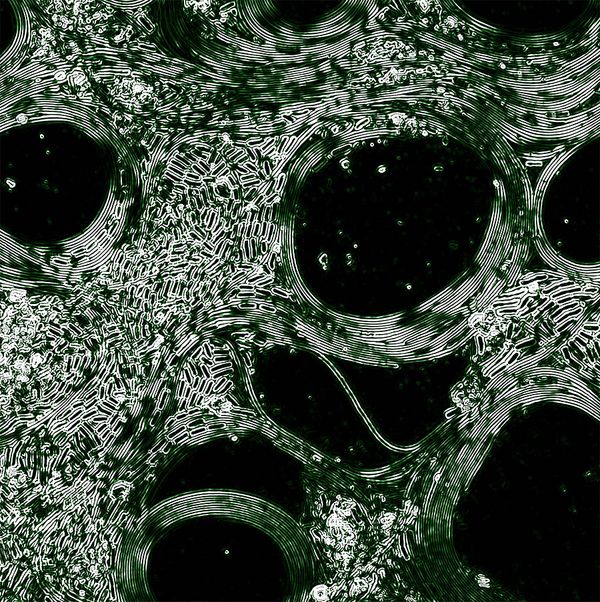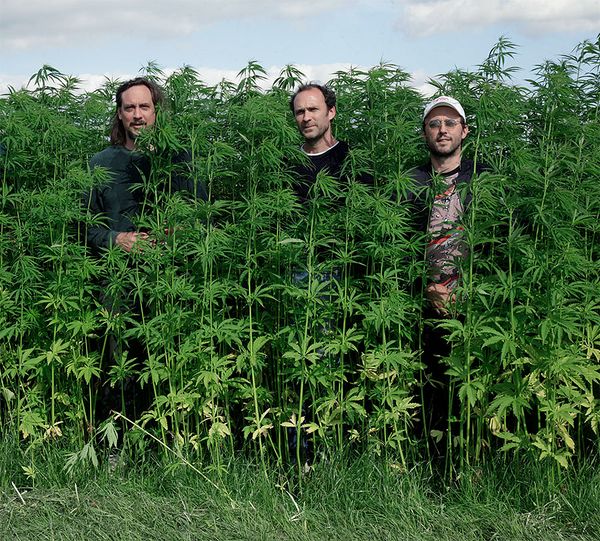Phytocene's creators: Nicolas Becker, Nicolas Desprat, and Agoria.
Phytocene is an NFT related to the collective work of musician Agoria, Oscar-winning sound designer Nicolas Becker, and bio-physicist Nicolas Desprat, produced and curated by 91.530 Le Marais. Phytocene, from the Ancient Greek word phytos (plant), is an immersion in the inner workings of Nature, an experimental work minting bioscience and music, at the heart of the intangible communication and Nature among itself. Here, the three collaborators discuss the project's origins, bridging cross-disciplinary differences, and what dialogues arise from the medium of NFTs.
Discover More about Phytocene >
PHILLIPS: How did you become involved in the project?
AGORIA: I was visiting the Domaine of Le Marais with Victoire de Pourtalès and Benjamin Eymère when the idea popped up in my mind. I was intrigued by their project of seeding fields of bamboo and hemp to draw what will become—within the next year—the surrounding of an arena. They first asked me to sonorise the seeding as a musician, but I wasn’t sure as I thought there was something quite unique going on which was more than a “soundtrack.” I wasn’t keen to just play a “show.” So, I called my old friend Nicolas Becker, a brilliant sound designer, and I explained my wish of creating a piece where the living system itself would turn into the artist.
NICOLAS BECKER: I got involved because I met Victoire through Agoria, and we started to speak about their artistic project in le Château. I started to explain to Victoire the work I was doing, the way I was using biological data to create sounds and music in collaboration with friends (artists Carlos Casas, Philippe Parreno, Ben Russell). We naturally started to think about the idea to monitor the hemp field. Then, very quickly, I thought about working with Nicolas Desprat. We worked together during two of Phillippe Parreno’s exhibitions, at the Turbine Hall in London and at the Gropius Bau in Berlin.
P: Phytocene is intensely collaborative—a union not just between thinkers, but between disciplines. What was it like working with collaborators whose work and background were so different from your own?
A: The main collaboration here is with Nature itself. Nature is in the center of everything we have created. We certainly captured her, but she has drawn, written and shown us the path. When Nicolas Becker introduced me to Nicolas Desprat, we connected at first sight. As a biophysicist, he has the perfect knowledge and ability to enlighten our hemp field. But most of all, I did feel his artistic vision matched the exemplarity of his research. I guess it’s our common speciality to cross disciplines. We were all happy to exit our codified territories; it helped us to work in total freedom.
NICOLAS DESPRAT: Being confronted with different backgrounds is always a very stimulating and inspiring experience. The work we tried to design was somewhat dictated by the nature of the subject itself: a small ecosystem where life unfolds on scales of time and length ranging from minutes to months and from microns to meters. So we used our own diversity to listen and observe our subject of study.

Agoria, Nicolas Becker, and Nicolas Desprat, Phytocene (detail), Minted on 1 July 2021. Estimate £15,000 - 20,000. New Now London.
P: Despite its highly contemporary nature, at the heart of Phytocene is something quite timeless: the relationship between humans, the organic world, and replication (say, Mary Shelley’s work, or even some Enlightenment writers). How do you think Phytocene builds on or complicates those histories and narratives?
ND: In all those works, the Nature is projected into a physical construction or subjected to an intellectual interpretation, which relates how humans conceive a controlled, understandable and reassuring Nature. The nature of Phytocene is in essence shamanic and aims to touch rather than think about it. The creative process of the piece started from the sound environment with this long and progressive crescendo that extends throughout the film. The visual narrative then unfolded by selecting sequences out of more than 1,000 hours of microbial life. Phytocene proposes an experience in the microbial kingdom, discreet but with massive impact. The touch of anxiety present in Phytocene aims at questioning of our fear of Nature. Since the rise of humanity, people have tried to control Nature because wilderness is something scary.
P: At what point did you decide to incorporate blockchain into the project?
A: If I am a fervent defender of artificial intelligence; living systems by their adaptive capacity remain the best examples of collective intelligence. Phytocene enlights the living. The NFT seemed to be the appropriate certification for this unfathomable state. By their process, the NFTs authenticate the birth and the growth of the hemp field at Le Marais. We authenticate the unreadable, beyond all points of view.
P: How does the incorporation of blockchain inform the meaning of the project? What dialogues arise from this medium?
A: The truth, it seems to me, lies beyond the evidence, beyond a code, elsewhere than in an algorithm or a writing. Truth is wilder, it is hidden in movement, in the living. The living has been represented many times, painted, photographed, filmed, in all its aspects. Nature is often reduced to the status of a set, interpreted, and disguised in the service of a human purpose. Here, our action will have been to illuminate, literally. The pieces reveal the birth of plant micro-organisms where we witness the origin and development of cells. The plant narrative is inherently natural and wild.
P: Was there anything unexpected or extraordinary that you discovered while working on the project?
NB: As usual I'm always impressed by the results. I think you can feel the liveness of the material, the potential beauty of the forms which are produced by hybridation between an artistic form and Nature.
ND: Definitely! We discovered a type of motility, which has not yet been reported in the scientific literature. Usually, bacteria move slowly and randomly over surfaces. The natural isolates of the Chateau du Marais contain a strain that moves very rapidly in almost perfect circles. This behavior requires a high energy cost to fuel the cell’s metabolism. How such a cost survived Darwinian evolution is a real puzzle.
P: How do you hope people will feel after experiencing Phytocene?
A: I feel it’s the first of a long series where we enlight our environment and the ecosystem as the center of the creation. It’s extraordinary to feel the beauty and the complexity of Nature and understand that a symbiosis is possible between humans and Nature. Let’s listen to Nature and find the right balance.
Discover More from New Now London >
Recommended Reading
Radical Originality: The Artists of Africa First >
Stella McCartney's Artist Alphabet >
